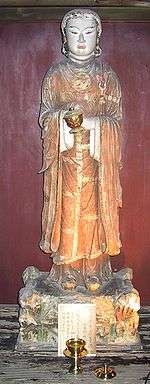Asuka-dera
Coordinates: 34°28′43″N 135°49′13″E / 34.478731°N 135.820214°E


Asuka-dera (飛鳥寺), also known as Hōkō-ji (法興寺), is a Buddhist temple in Asuka, Nara. Asuka-dera is regarded as one of the oldest temples in Japan.
Temple complex
A number of records refer to the origin of the temple, such as the Nihongi and Fusō-ryakuki. The original buildings of what was then called Hōkō-ji were constructed in 588 under the guidance of craftsmen from the ancient Korean kingdom of Baekje , shortly after the introduction of Buddhism from Baekje, one of the three principal states on the Korean peninsula, according to various sources including Buddhism in Japan.[1][2]
Following the transfer of the capital from Asuka to Heijō-kyō (now Nara city), the buildings of Asuka-dera were also removed from the original site in Asuka to Nara in 718 CE, and developed into a huge temple under the name of Gangō-ji. The original site of the Hōkō-ji was also maintained as a temple which survives into modern times.[1]
The main object of worship at Asuka-dera is the bronze Great Buddha, which said to be made by Kuratsukuri no Tori in the early seventh century. The statue is a designated an Important Cultural Property.

See also
- Gangō-ji
- Historical Sites of Prince Shōtoku
- For an explanation of terms concerning Japanese Buddhism, Japanese Buddhist art, and Japanese Buddhist temple architecture, see the Glossary of Japanese Buddhism.
References
- 1 2 Martin, John et al. (1993). Nara: A Cultural Guide to Japan's Ancient Capital, p. 121;
- ↑ Aston, William. (2005). Nihongi, p. 101.
Bibliography
- Aston, William G. (2005). Nihongi: Chronicles of Japan from the Earliest Times to A.D. 697. Tokyo: Charles E. Tuttle Company. ISBN 0-8048-3674-4
- Brown, Delmer M. and Ichirō Ishida, eds. (1979). [ Jien, c. 1220], Gukanshō (The Future and the Past, a translation and study of the Gukanshō, an interpretative history of Japan written in 1219). Berkeley: University of California Press. ISBN 0-520-03460-0
- Martin, John H. and Phyllis G. Martin. (1993). Nara: A Cultural Guide to Japan's Ancient Capital. Tokyo: Tuttle Publishing. ISBN 978-0-8048-1914-5
- Shimura, Izuru. (1998). Kōjien, 5th edition. Tokyo: Iwanami Shoten. ISBN 978-4-00-080111-9 (cloth)
- Ponsonby-Fane, Richard Arthur Brabazon. (1959). The Imperial House of Japan. Kyoto: Ponsonby Memorial Society. OCLC 194887
- Titsingh, Isaac, ed. (1834). [Siyun-sai Rin-siyo/Hayashi Gahō, 1652], Nipon o daï itsi ran; ou, Annales des empereurs du Japon. Paris: Oriental Translation Fund of Great Britain and Ireland.
- Varley, H. Paul , ed. (1980). [ Kitabatake Chikafusa, 1359], Jinnō Shōtōki ("A Chronicle of Gods and Sovereigns: Jinnō Shōtōki of Kitabatake Chikafusa" translated by H. Paul Varley). New York: Columbia University Press. ISBN 0-231-04940-4
External links
- Asuka Historical Museum website
- Gango-ji as world heritage site (JAL)
- Gango-ji in context of Nara tourism
| Wikimedia Commons has media related to Asukadera. |